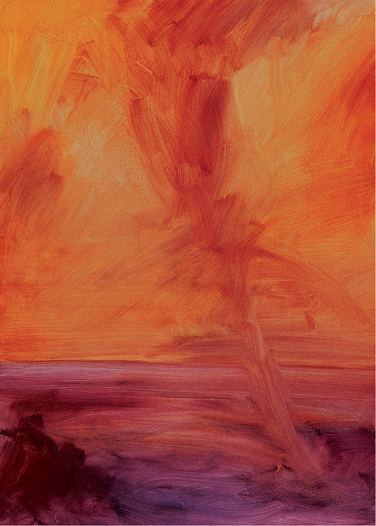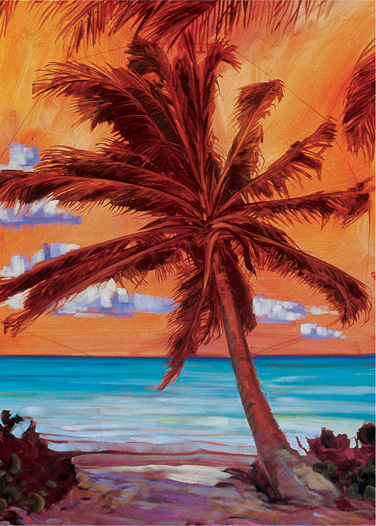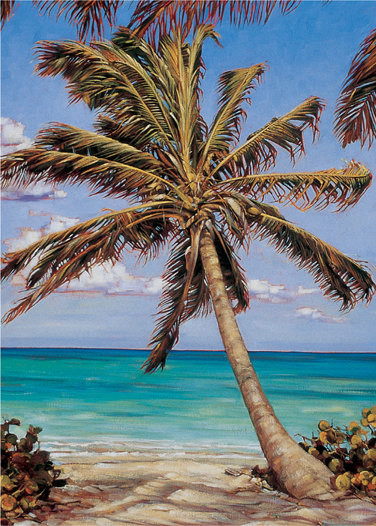OIL LESSON 1
Seascape with Caroline Zimmermann
A thin layer applied to the support as a base color, an underpainting influences any color painted over it. Artists usually underpaint with hues similar to the color of their subject, but you can achieve incredible results by doing just the opposite! For this tropical seascape, begin by covering the canvas with oranges and reds to contrast with the blues, greens, and grays of nature. The subtle radiance of these undercolors intensifies the subsequent layers of paint!

1 To create an underpainting that will contrast beautifully with the greens and blues of this tropical scene, use a mix of alizarin crimson, dioxazine purple, Indian yellow, transparent orange, and magenta. Thin the mixture with turpentine so it will spread easily over the canvas, and apply the thinned color with a medium flat brush. The top 2/3 of the canvas will be dedicated to the sky, so use a lot of orange in this area. (Orange is the pure complement of blue.) Do this with a mix of Indian yellow, transparent orange, and quinacridone pink. Allow the paint to dry before continuing to the next step.

2 Mix alizarin crimson with a little dioxazine purple and a few drops of turpentine. Then, using a medium flat brush, sketch the composition, establishing the horizon and the lines of the palm tree’s trunk. Make dots where you will place the ends of the leaves, and connect the dots to create the palm’s shape. Finish blocking in the basic shapes by adding more purple to the crimson mixture and designating the darker areas of the trunk, the leaves in the bushes, and the shadows below the tree. (To create the palm leaves, see the detail on page 7.)

3 Paint the water at the horizon using ultramarine blue, mixing in tints of phthalo blue and phthalo green and gradually adding more white as you near the shore. Add a touch of lemon yellow for the shallowest areas. Mix white with transparent orange, Indian yellow, and dioxazine purple for the sand. Darken the foliage with a mix of ultramarine blue, dioxazine purple, and sap green. For the darks of the clouds, mix dioxazine purple, ultramarine blue, and a little white.

4 For the sky, mix one part ultramarine blue to three parts white and just a dab of phthalo blue. Create the palm leaves by painting the sky around and between them (see the box on page 7). Add light blue mixtures of phthalo green and phthalo blue to the water. For the shallowest water, use white mixed with a dab of dioxazine purple and Indian yellow. Add a bit more yellow and orange to the white for the sand highlights. Paint the dark palm leaves with sap green mixed with alizarin crimson.

5 After allowing the painting to dry, focus on the palm tree. Concentrate on showing the motion the wind creates as it blows through the leaves. Follow the steps outlined in the detail on page 7 to develop the palm fronds. Then paint the center of the tree, making your strokes follow the round shape of the trunk. Paint the coconuts and the texture of the trunk with mixtures of dioxazine purple, transparent orange, and some of the green mixtures from the palm leaves detail.

6 Apply the brightest highlights of the leaves, trunk, sand, water, and clouds so that these elements seem to shimmer in the tropical sunlight. Finish the painting by applying a glaze over the entire surface to unify the painting and adjust some of the colors. Your goals are to deepen the top of the blue sky, tone down the red of the upper branches, and deepen the foreground shadows. So prepare a glaze with a hint of ultramarine blue added to a fast-drying medium and apply it to the upper areas and the foreground with a small flat brush. Then coat the entire painting with a clear glaze of the same medium, rubbing away the excess with a rag.






